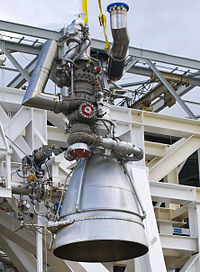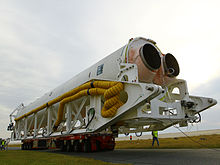NK-33
 The Russian NK-33 was modified and renamed the AJ26-58 by Aerojet. This AJ26-58 is shown during a test firing at Stennis Space Center | |
| Country of origin | Russia |
|---|---|
| Date | 1970s |
| Designer | Kuznetsov Design Bureau |
| Manufacturer | Aerojet |
| Application | 1st stage multi-engine |
| Predecessor | NK-15, NK-15V |
| Successor | AJ26-58, AJ26-59 |
| Liquid-fuel engine | |
| Propellant | LOX / RP-1 (rocket grade kerosene) |
| Cycle | Staged combustion |
| Pumps | Turbopump |
| Performance | |
| Thrust, vacuum | 1,753.8 kN (394,300 lbf) |
| Thrust, sea-level | 1,505 kN (338,000 lbf) |
| Thrust-to-weight ratio | 137 |
| Chamber pressure | 145 bar (14,500 kPa) |
| Specific impulse, vacuum | 331 s |
| Specific impulse, sea-level | 297 s |
| Dimensions | |
| Length | 3.7 m (12 ft) |
| Diameter | 2 m (6 ft 7 in) |
| Dry mass | 1,235 kg (2,723 lb) |
The NK-33 and NK-43 are rocket engines designed and built in the late 1960s and early 1970s by the Kuznetsov Design Bureau. They were intended for the ill-fated Soviet N-1 rocket moon shot. The NK-33 engine is among the highest thrust-to-weight ratio of any Earth-launchable rocket engine (second only to SpaceX Merlin 1D engine), while achieving a very high specific impulse. NK-33 was by many measures the highest performance LOX/Kerosene rocket engine ever created.[1]
The NK-43 is similar to the NK-33, but is designed for an upper stage, not a first stage. It has a longer nozzle, optimized for operation at altitude, where ambient air pressure is low or perhaps zero. This gives it a higher thrust and specific impulse, but makes it longer and heavier.
In 2010 stockpiled NK-33 engines were successfully tested for use by the Orbital Sciences Antares light-to-medium-lift launcher.[2]
Technology
NK-33 and NK-43 are derived from the earlier NK-15 and NK-15V engines, respectively.
The engines are high pressure, regeneratively cooled staged combustion cycle bipropellant rocket engines, and use oxygen-rich preburners to drive the turbopumps. The turbopumps require subcooled LOX to cool the bearings. These kinds of burners are highly unusual, since their hot, oxygen-rich exhaust tends to attack metal, causing burn-through failures. The Soviets, however, perfected the metallurgy behind this method. The nozzle was constructed from corrugated metal, brazed to an outer and inner lining, giving a simple, light but strong structure. In addition, since the NK-33 uses subcooled LOX and kerosene, which have similar densities, a single rotating shaft could be used for both turbopumps.[3] Given its longer, heavier nozzle, the NK-43 ratio in vacuo is slightly heavier with a thrust-to-weight ratio of about 120:1.[4]
The oxygen-rich technology lives on in the RD-170/-171 engines, and their RD-180 and recently developed RD-191 derivatives.
History
The N-1 launcher originally used NK-15 engines for its first stage, and a high-altitude modification (NK-15V) in its second stage. After four consecutive launch failures and no successes, the project was cancelled. While other aspects of the vehicle were being modified or redesigned, Kuznetsov improved his contributions into the NK-33 and NK-43, respectively.[5] The 2nd-generation vehicle was to be called the N-1F. By this point the Moon race was long lost, and the Soviet space program was looking to the Energia as its heavy launcher. No N-1F ever reached the launch pad.[citation needed]
When the N-1 program was shut down, all work on the project was ordered destroyed. A bureaucrat instead took the engines, worth millions of dollars each, and stored them in a warehouse. Word of the engines eventually spread to America. Nearly thirty years after they were built, disbelieving rocket engineers were led to the warehouse. Later, one of the engines was taken to America, and the precise specification of the engine was demonstrated on a test stand.
About 150 engines survived, and in the mid-1990s, Russia sold 36 engines to Aerojet General for $1.1 million each. This company also acquired a license for the production of new engines. Aerojet has modified and renamed the updated NK-33 and NK-43 to AJ26-58 and AJ26-59, respectively.[6][7]
Kistler Aerospace, later called Rocketplane Kistler (RpK), designed their K-1 rocket around three NK-33s and an NK-43. On August 18, 2006, NASA announced that RpK had been chosen to develop Commercial Orbital Transportation Services for the International Space Station. The plan called for demonstration flights between 2008 and 2010. RpK would have received up to $207 million if they met all NASA milestones,[8][9][10] but on September 7, 2007, NASA issued a default letter warning that it would terminate the COTS agreement with Rocketplane Kistler in 30 days because RpK had not met several contract milestones.[11]
Proposals existed to retrofit the Soyuz launcher with NK-33s. Either one engine would replace the Soyuz's central RD-108, or five NK-33s would replace the RD-108 and four booster RD-107s. The lower weight and greater efficiency would increase payload; the simpler design and use of surplus hardware might actually reduce cost.[12]
Current and proposed uses
Antares

The Orbital Sciences Antares light-to-medium-lift launcher has two modified NK-33 in its first stage, a solid second stage and a hypergolic orbit stage.[13] The NK-33s are first imported from Russia to the United States and then modified into Aerojet AJ26s, which involves removing some harnessing, adding U.S. electronics, qualifying it for U.S. propellants, and modifying the steering system.[2]
The Antares rocket was successfully launched from NASA's Wallops Flight Facility on April 21, 2013. This marked the first successful launch of the NK-33 heritage engines built in early 1970s.[14]
Aerojet has agreed to recondition sufficient NK-33s to serve Orbital's 16 flight NASA Commercial Resupply Services contract. Beyond that, it has a stockpile of 23 1960s/70s era engines. Kuznetsov no longer manufactures the engine, and the lack of a continuing supplier brings into question the long term viability of Antares. To address this, Orbital has sought to buy RD-180 engines, but maker NPO Energomash's contract with United Launch Alliance prevents this. Aerojet has offered to work with Kuznetsov to restart production of new NK-33 engines, to assure Orbital of an ongoing supply.[15]
Aurora-L.SK
RSC Energia is proposing an 'Aurora-L.SK' launch vehicle which would use an NK-33 to power the first stage and a Block DM-SL for the second stage.[16] TsSKB-Progress also plans to use NK-33 as the main engine of the lightweight version of the successful Soyuz rocket family under development, called Soyuz-1.[17] The NK-33A intended for the Soyuz-1 was successfully hot-fired on January 15, 2013,[18] following a series of cold-fire and systems tests of the fully assembled Soyuz-1 in 2011-2012.[19]
Space Launch System
On June 17, 2011, Aerojet announced a strategic partnership with Teledyne Brown which would begin producing a US built version of the AJ-26, with its thrust increased to 500,000 lbf at sea level and will be produced at Teledyne's factory in Huntsville, Alabama. Their hope is to utilize this new, upgraded AJ-26 for the next generation Space Launch System.[20]
Gallery
-
An NK-33, renamed to Aerojet AJ26, in a Test Stand at Stennis Space Center.
-
An Aerojet AJ26 rocket engine being delivered to the Stennis Space Center.
-
NASA Administrator Charlie Bolden (left) and Stennis Space Center Director Patrick Scheuermann view a test firing of the first Aerojet AJ26 flight engine.
See also
References
- ^ "NK-33 and NK-43 Rocket Engines".
- ^ a b Clark, Stephen (March 15, 2010). "Aerojet confirms Russian engine is ready for duty". Spaceflight Now. Retrieved 2010-03-18.
- ^ Astronautix NK-33 entry
- ^ Astronautix NK-43 entry
- ^ Lindroos, Marcus. THE SOVIET MANNED LUNAR PROGRAM MIT. Accessed: 4 October 2011.
- ^ "Space Lift Propulsion". Aerojet. April 2011.
- ^ [1]
- ^ "NASA selects crew, cargo launch partners". Spaceflight Now. August 18, 2006.
- ^ "NASA Selects Crew and Cargo Transportation to Orbit Partners". SpaceRef. August 18, 2006.
- ^ Alan Boyle (August 18, 2006). "SpaceX, Rocketplane win spaceship contest". MSNBC.
- ^ "RpK's COTS Contract Terminated" (Press release). Aviation Week. 2007-09-10. Retrieved 2007-09-10.
- ^ "The Soyuz 1 (Soyuz 2-1v) Rocket". Russian Space Web. November 2010.
- ^ "Antares". Orbital.
- ^ Bill Chappell (21 April 2013). "Antares Rocket Launch Is A Success, In Test Of Orbital Supply Vehicle". NPR.
- ^ Amy Butler (24 June 2013). "Orbital Frustrated By Lack Of Antares Engine Options". Aviation Week and Space Technology.
- ^ "S.P.Korolev RSC Energia - LAUNCHERS". Energia.
- ^
Zak, Anatoly. "The Soyuz-1 rocket". Russian Space Web. Retrieved 7 March 2010.
{{cite web}}: External link in|publisher= - ^ "NK-33 Engine Test Successful" (in rus). Samara Today. Retrieved January 2013.
{{cite web}}: Check date values in:|accessdate=(help)CS1 maint: unrecognized language (link) - ^ http://www.kosmonavtika.com/lanceurs/soyouz/version/14A15/14A15.html
- ^ Morring, Frank. "NASA Will Compete Space Launch System Booster". aviationweek.com. Retrieved 20 June 2011.




